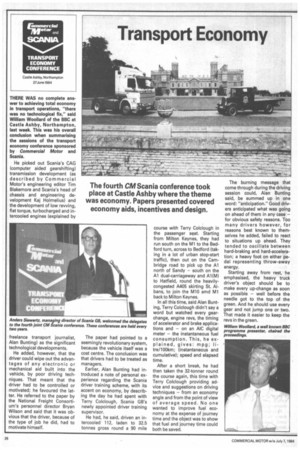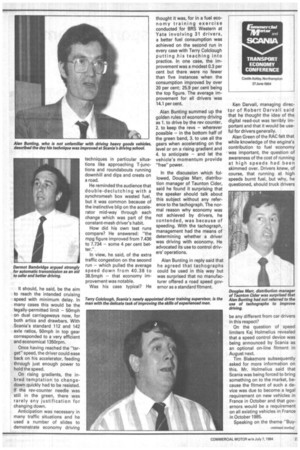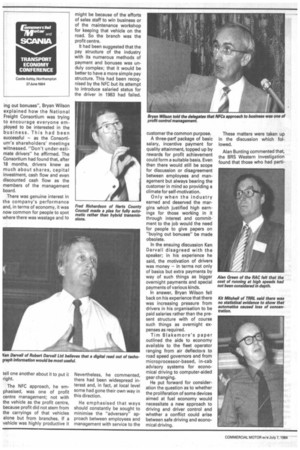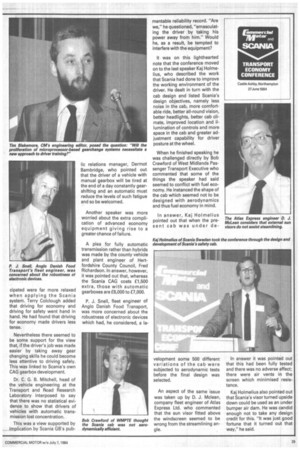Transport Economy
Page 28

Page 29

Page 30

Page 31

If you've noticed an error in this article please click here to report it so we can fix it.
THERE WAS no complete answer to achieving total economy in transport operations, "there was no technological fix," said William Woollard of the BBC at Castle Ashby, Northampton, last week. This was his overall conclusion when summarising the sessions of the transport economy conference sponsored by Commercial Motor and Scania.
He picked out Scania's CAG (computer aided gearshifting) transmission development (as described by Commercial Motor's engineering editor Tim Blakemore and Scania's head of chassis and engineering development Kaj Holmelius) and the development of low revving, flat torque, turbocharged and intercooled engines (explained by freelance transport journalist, Alan Bunting) as the significant technological developments.
He added, however, that the driver could wipe out the advantages of any electronic or mechanical aid built into the vehicle, by poor driving techniques. That meant that the driver had to be controlled or motivated; he favoured the latter. He referred to the paper by the National Freight Consortium's personnel director Bryan Wilson and said that it was obvious that the driver, because of the type of job he did, had to motivate himself. The paper had pointed to a seemingly revolutionary system, because the vehicle itself was a cost centre. The conclusion was that drivers had to be treated as managers.
Earlier, Alan Bunting had introduced a note of personal experience regarding the Scania driver training scheme, with its accent on economy, by describing the day he had spent with Terry Colclough, Scania GB's newly appointed driver training supervisor.
He had, he said, driven an intercooled 112, laden to 32.5 tonnes gross round a 90 mile course with Terry Colclough in the passenger seat. Starting from Milton Keynes, they had run south on the M1 to the Bedford turn, across to Bedford (taking in a lot of urban stop-start traffic), then out on the Cambridge road to pick up the Al north of Sandy — south on the Al dual-carriageway and Al(M) to Hatfield, round the heavilycongested A405 skirting St. Albans, to join the M10 amd M1 back to Milton Keynes.
In all this time, said Alan Bunting, Terry Colclough didn't say a word but watched every gearchange, engine revs, the timing of accelerator and brake applications and — on an AIC digital meter — the instantaneous fuel consumption. This, he explained, gives: mpg; litre/100km; (instantaneous and cumulative); speed and elapsed time.
After a short break, he had then taken the 32-tonner round the course again, this time with Terry Colclough providing advice and suggestions on driving techniques — from an economy angle and from the point of view of average speed. No one wanted to improve fuel economy at the expense of journey time and the object was to show that fuel and journey time could both be saved. The burning message that come through during the driving session could, Alan Bunting said, be summed up in one word: "anticipation." Good drivers anticipated what was going on ahead of them in any case — for obvious safety reasons. Too many drivers however, for reasons best known to themselves he added, failed to react to situations up ahead. They tended to oscillate between hard-braking and hard-acceleration; a heavy foot on either pedal representing throw-away energy.
Starting away from rest, he emphasised, the heavy truck driver's object should be to make every up-change as soon as possible — well before the needle got to the top of the green. And he should use every gear and not jump one or two. That made it easier to keep the revs in the green. It should, he said, be the aim to reach the intended cruising speed with minimum delay. In many cases this would be the legally-permitted limit — 50mph on dual carriageways now, for both artics and drawbars. With Scania's standard 112 and 142 axle ratios, 50mph in top gear corresponded to a very efficient and economical 1350rpm.
Once having reached the "target" speed, the driver could ease back on his accelerator, feeding through just enough power to hold the speed.
On rising gradients, the inbred temptation to changedown quickly had to be resisted. If the rev-counter needle was still in the green, there was rarely any justification for changing down.
Anticipation was necessary in many traffic situations and he used a number of slides to demonstrate economy driving techniques in particular situations like approaching T-junctions and roundabouts running downhill and dips and crests on a road.
He reminded the audience that double-declutching with a synchromesh box wasted fuel, but it was common because of the instinctive blip on the accelerator mid-way through each change which was part of the constant-mesh driver's habit.
How did his own test runs compare? He answered: "the mpg figure improved from 7.436 to 7.734 — some 4 per cent better."
In view, he said, of the extra traffic congestion on the second run — which pulled the average speed down from 40.38 to 38.5mph — that economy improvement was notable.
Was his case typical? He thought it was, for in a fuel economy training exercise conducted for BRS Western at Yate involving 31 drivers, a better fuel consumption was achieved on the second run in every case with Terry Colclough putting his teaching into practice. In one case, the improvement was a modest 0.3 per cent but there were no fewer than five instances when the consumption improved by over 20 per cent; 25.9 per cent being the top figure. The average improvement for all drivers was 14.1 per cent.
Alan Bunting summed up the golden rules of economy driving as 1. to drive by the rev counter, 2. to keep the revs — wherever possible — in the bottom half of the green band, 3. to use all the gears when accelerating on the level or on a rising gradient and 4. to anticipate — and let the vehicle's momentum provide "free" power.
In the discussion which followed, Douglas Marr, distribution manager of Taunton Cider, said he found it surprising that the speaker should talk about this subject without any reference to the tachograph. The normal reason why economy was not achieved by drivers, he contended, was because of speeding. With the tachograph, management had the means of determining whether a driver was driving with economy, He advocated its use to control drivers' operations.
Alan Bunting in reply said that he agreed that tachographs could be used in this way hut was surprised that no manufacturer offered a road speed governor as a standard fitment. Ken Darvall, managing director of Robert Darvall said that he thought the idea of the digital read-out was terribly important and that it would be useful for drivers generally.
Alan Green of the RAC felt that while knowledge of the engine's contribution to fuel economy was important, the question of awareness of the cost of running at high speeds had been skimmed over. Drivers knew, of course, that running at high speeds burnt fuel, but why, he questioned, should truck drivers be any different from car drivers in this respect?
On the question of speed limiters Kaj Holmelius revealed that a speed control device was being announced by Scania as an optional on-line fitment in August next.
Tim Blakemore subsequently asked for more information on this. Mr. Holmelius said that Scania was being forced to bring something on to the market, because the fitment of such a device was due to become a legal requirement on new vehicles in France in October and that governors would be a requirement on all existing vehicles in France in October 1985.
Speaking on the theme "Buy
ing out bonuses", Bryan Wilson explained how the National Freight Consortium was trying to encourage everyone employed to be interested in the business. This had been successful — as the Consortium's shareholders' meetings witnessed. "Don't under-estimate drivers" he affirmed. The Consortium had found that, after 18 months, drivers knew as much about shares, capital investment, cash flow and even discounted cash flow as the members of the management board.
There was genuine interest in the company's performance and, in terms of economy, it was now common for people to spot where there was wastage and to tell one another about it to put it right.
The NFC approach, he emphasised, was one of profit centre management; not with the vehicle as the profit centre, because profit did not stem from the carryings of that vehicles alone but from branches. If a vehicle was highly productive it might be because of the efforts of sales staff to win business or of the maintenance workshop for keeping that vehicle on the road. So the branch was the profit centre.
It had been suggested that the pay structure of the industry with its numerous methods of payment arid bonuses was unduly complex; that it would be better to have a more simple pay structure. This had been recognised by the NFC but its attempt to introduce salaried status for the driver in 1983 had failed.
Nevertheless, he commented, there had been widespread interest and, in fact, at local level some had gone their own way in this direction.
He emphasised that ways should constantly be sought to minimise the "adversary" approach between employees and management with service to the customer the common purpose.
A three-part package of basic salary, incentive payment for quality attainment, topped up by rewards for profit achievement could form a suitable basis. Even then there would still be scope for discussion or disagreement between employees and management but always bearing the customer in mind so providing a climate for self-motivation.
Only when the industry earned and deserved the margins which justified high earnings for those working in it through interest and commitment to the job would the need for people to give papers on "buying out bonuses" be made obsolete.
In the ensuing discussion Ken Darvall disagreed with the speaker; in his experience he said, the motivation of drivers was money — in terms not only of basics but extra payments by way of such things as bigger overnight payments and special payments of various kinds.
In answer, Bryan Wilson fell back on his experience that there was increasing pressure from drivers in his organisation to be paid salaries rather than the present structure with of course such things as overnight expenses as required.
Tim Blakemore's paper outlined the aids to economy available to the fleet operator ranging from air deflectois to road speed governors and from microprocessor-based, in-cab advisory systems for economical driving to computer-aided gear changing.
He put forward for consideration the question as to whether the proliferation of some devices aimed at fuel economy would necessitate a new approach to driving and driver control and whether a conflict could arise between safe driving and economical driving. cipated were far more relaxed when applying the Scania system. Terry Colclough added that driving for economy and driving for safety went hand in hand. He had found that driving for economy made drivers less tense.
Nevertheless there seemed to be some support for the view that, if the driver's job was made easier by taking away gear changing skills he could become less attentive to driving safely. This was linked to Scania's own CAG gearbox development.
Dr. C. G. B. Mitchell, head of the vehicle engineering at the Transport and Road Research Laboratory interposed to say that there was no statistical evidence to show that drivers of vehicles with automatic transmission lost concentration.
This was a view supported by implication by Scania GB's pub lic relations manager, Dermot Bambridge, who pointed out that the driver of a vehicle with manual gearbox will be tired at the end of a day constantly gearshifting and an automatic must reduce the levels of such fatigue and so be welcomed.
Another speaker was more worried about the extra complication of advanced economy equipment giving rise to a greater chance of failure.
A plea for fully automatic transmission rather than hybrids was made by the county vehicle and plant engineer of Hertfordshire County Council, Fred Richardson. In answer, however, it was pointed out that, whereas the Scania CAG costs £1,500 extra, those with automatic gearboxes are £6,000 to £7,000.
P. J. Snell, fleet engineer of Anglo Danish Food Transport, was more concerned about the robustness of electronic devices which had, he considered, a la It was on this lighthearted note that the conference moved on to the last speaker Kaj Holmelius, who described the work that Scania had done to improve the working environment of the driver. He dealt in turn with the cab design and listed Scania's design objectives, namely less noise in the cab, more comfortable ride, better all-round vision, better headlights, better cab climate, improved location and illumination of controls and more space in the cab and greater adjustment capability for driver posture at the wheel.
When he finished speaking he was challenged directly by Bob Crawford of West Midlands Passenger Transport Executive who commented that some of the things the speaker had said seemed to conflict with fuel economy. He instanced the shape of the cab which seemed not to be designed with aerodynamics and thus fuel economy in mind.
In answer, Kaj Holmelius pointed out that when the present cab was under de velopment some 500 different variations of the cab were subjected to aerodynamic tests before the final design was selected.
An aspect of the same issue was taken up by D. J. Mclean, company fleet engineer of Atlas Express Ltd. who commented that the sun visor fitted above the windscreen seemed to be wrong from the streamlining angle. In answer it was pointed out that this had been fully tested and there was no adverse affect; there were air vents in the screen which minimised resistance.
Kaj Holmelius also pointed out that Scania's visor turned upside down could be used as an under bumper air dam. He was candid enough not to take any design credit for this. "It was just good fortune that it turned out that way," he said.




























































































